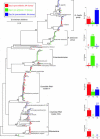Antibiotic-associated diarrhea accompanied by large-scale alterations in the composition of the fecal microbiota
- PMID: 15004076
- PMCID: PMC356823
- DOI: 10.1128/JCM.42.3.1203-1206.2004
Antibiotic-associated diarrhea accompanied by large-scale alterations in the composition of the fecal microbiota
Abstract
Alterations in the diversity of the gut microbiota are believed to underlie the development of antibiotic-associated diarrhea (AAD). A molecular phylogenetic analysis was performed to document temporal changes in the diversity of fecal bacteria of a patient who developed AAD. Antibiotic administration was associated with distinct changes in the diversity of the gut microbiota, including a marked decrease in the prevalence of butyrate-producing bacteria. Following the discontinuation of the antibiotic, resolution of diarrhea was accompanied by a reversal of these changes, providing the first direct evidence linking changes in the community structure of the gastrointestinal bacteria with the development of AAD.
Figures

Comment in
-
Antibiotic-associated diarrhea: it's all about the butyrate.Rev Gastroenterol Disord. 2004 Fall;4(4):216-7. Rev Gastroenterol Disord. 2004. PMID: 15584142 No abstract available.
References
-
- Attebery, H. R., V. L. Sutter, and S. M. Finegold. 1972. Effect of a partially chemically defined diet on normal human fecal flora. Am. J. Clin. Nutr. 25:1391-1398. - PubMed
-
- Bartlett, J. G. 2002. Clinical practice. Antibiotic-associated diarrhea. N. Engl. J. Med. 346:334-339. - PubMed
-
- Cole, J. R., B. Chai, T. L. Marsh, R. J. Farris, Q. Wang, S. A. Kulam, S. Chandra, D. M. McGarrell, T. M. Schmidt, G. M. Garrity, and J. M. Tiedje. 2003. The Ribosomal Database Project (RDP-II): previewing a new autoaligner that allows regular updates and the new prokaryotic taxonomy. Nucleic Acids Res. 31:442-443. - PMC - PubMed
Publication types
MeSH terms
Substances
LinkOut - more resources
Full Text Sources
Other Literature Sources
Medical
Molecular Biology Databases

